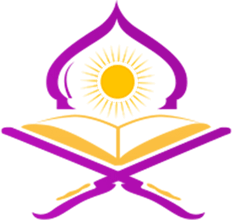Laam Shamsiya and Laam Qamariya are like the sun and moon guiding Arabic pronunciation. When Laam Shamsiya meets one of 14 “sun letters,” it silently blends in, causing the next letter to shine brightly with a double stress, as in “الشمس” (ash-shams).
Conversely, Laam Qamariya, facing 14 “moon letters,” retains its glow, clearly pronounced alongside the following letter, as in “القمر” (al-qamar). Mastering these rules is key to illuminating the beauty and rhythm of Arabic, whether in everyday speech or the lyrical flow of Quranic recitation.
In the Arabic language, we have two kinds of the letter LAAM, and it’s called Laam Shamsiya and Laam Qamariya. The difference between Laam Shamsiya And Laam Qamariya is the pronunciation of the letter (Lam) in Arabic.
In this article, we will explain Laam Shamsiya and Laam Qamariya, how to differentiate between them, and illustrated examples from the Holy Quran that show the difference between the two.
Table of Contents
The Types of Laam in Arabic:
In Arabic grammar, there are several types of “Laam” that serve different functions in language structure. The most notable types are Laam Shamsiya and Laam Qamariya, which are integral to the pronunciation rules for definite nouns.
Laam Shamsiya, or “sun letter,” assimilates with certain letters following it, causing the Laam to be silent, such as in “الشمس” (ash-shams). In contrast, Laam Qamariya, or “moon letter,” retains its pronunciation, as in “القمر” (al-qamar).
Rules of Laam Shamsiya and Laam Qamariya Definition:
Laam Shamsiya and Laam Qamariya set of exclusive rules that distinguish each of them from the other:
1- The Rules of Laam Shamsiya:
Laam Shamsiya is always used at the beginning of nouns. It does not appear in the middle or end of words. For example: “الشمس” (ash-shams) – “the sun”.
When Laam Shamsiya precedes a Shamsi letter, the Laam is not pronounced. Instead, the Shamsi letter that follows it is stressed with a Shaddah ( ّ ). For example: “الشمس” (ash-shams) is pronounced without the Laam sound, focusing on the doubled “sh” sound.
2- The Rules of Laam Qamariya:
Laam Qamariya is also used only at the beginning of nouns. It does not appear in the middle or end of words. For example: “القمر” (al-qamar) – “the moon”.
When Laam Qamariya precedes a Qamari letter, both the Laam and the Qamari letter are pronounced clearly and distinctly. For example: “القمر” (al-qamar) retains the pronunciation of both the Laam and the “q” sound.
What is the Laam Shamsiya?
“Laam Shamsiya” is an Arabic term that translates to “Sun Letter” in English. In Arabic grammar, it refers to the phenomenon where the definite article “Al” assimilates with the following letter if it is a “Shamsi” letter.
Laam Shamsiya is a defining lam “the” in English. Laam Shamsiya is added to the nouns of things to be a Definite noun, and it is the lam that is written in the word and we do not pronounce it during the reading.
The name Laam Shamsiya is taken from the word “sun” in Arabic because the word sun “shams” is actually an example of the Laam Shamsiya Rule. Laam Shamsiya refers to the word that has a Lam that would not be pronounced.
For example, the word sun in Arabic is “Shams” when you add the “the” to it (ال – Alif and Lam) the word would not be pronounced as “alshams” but rather “ashams” without pronouncing the lam letter.
The Laam becomes laam shamsiya when comes before one of the following 14 letters that are called the Laam Shamsiya letters:
- In Arabic (ت ، ث ، د ، ذ ، ر ، ز ، س ، ش ، ص ، ض ، ط ، ظ ، ن ، ل)
- The Transliteration of these letters in English are: (t / th / d / y / r / g / s / sh / r / z / i / y / n / l)
When the letters alf Lam come before these letters, the lam would on be pronounced, and the letter that follows it comes with stress or Shadah ( ّ ).
Example of laam Shamsiya: (وَالتِّينِ وَالزَّيْتُونِ)
Did you notice how these two words were pronounced? You will find yourself not pronouncing the “lam” in them despite its presence as clear as the sun, and you will find that the letter that came after it in the first word is the letter “t” and the second word is the letter “Z” and you will find the two letters stressed.
You can now identify the shamsiya lam if you find any of these letters after it.
Laam Shamsiya Letters (Sular Letters):
The term “Laam Shamsiya” refers to the Arabic definite article “Al” (ال) and its assimilation with the following letter if it is a “Shamsi” letter. Shamsi letters are those with a solar or sunny nature. When “Al” precedes a word that starts with one of these letters, the “L” sound in “Al” assimilates into the following letter. Here is the list of Shamsi letters:
- ت (taa)
- ث (tha)
- د (dal)
- ذ (dhal)
- ر (ra)
- ز (za)
- س (sa)
- ش (sha)
- ص (sad)
- ض (dad)
- ط (taa)
- ظ (zha)
In the context of “Laam Shamsiya,” it’s specifically about the assimilation of the “L” sound in “Al” with these Shamsi letters when they occur at the beginning of a word. This assimilation is a pronunciation rule in Arabic grammar.
Laam Shamsiya examples:
These examples demonstrate how the “Laam Shamsiya” rule applies when the definite article “Al” precedes words starting with the specified Shamsi letters in Arabic. Here are examples of “Laam Shamsiya” in Arabic:
1- الشمس (Al-Shams) – The sun:
In pronunciation, you say “Ash-Shams” because the “L” sound assimilates into the following “Sh” sound.
2- الزهراء (Al-Zuhraa) – The planet Venus:
In pronunciation, you say “Az-Zuhraa” because the “L” sound assimilates into the following “Z” sound.
3- السماء (Al-Samaa) – The sky:
In pronunciation, you say “As-Samaa” because the “L” sound assimilates into the following “S” sound.
4- الشجرة (Al-Shajarah) – The tree:
In pronunciation, you say “Ash-Shajarah” because the “L” sound assimilates into the following “Sh” sound.
5- الدرس (Al-Dars) – The lesson:
In pronunciation, you say “Ad-Dars” because the “L” sound assimilates into the following “D” sound.
6- الصحراء (Al-Sahraa) – The desert:
In pronunciation, you say “As-Sahraa” because the “L” sound assimilates into the following “S” sound.
These examples demonstrate how the “Laam Shamsiya” rule applies when the definite article “Al” precedes words starting with the specified Shamsi letters in Arabic.
What is Laam Qamariya?
“Laam Qamariya” or “lunar laam” refers to another pronunciation rule in Arabic grammar similar to “Laam Shamsiya.” It involves the assimilation of the definite article “Al” (ال) with the following letter if it is a “Qamari” letter. Qamari letters are those with a lunar or moon-like nature.
Laam Qamariya is the definition of lam, which is added to the noises of things to be Definite nouns in Arabic. Laam Qamariya is written at the beginning of the and is clearly pronounced with the following letter.
The name of Lam Qamariya is taken from the Arabic word for the moon “Qamar”. Because the word moon in Arabic “shams” is actually an example of the Lam Qamariya Rule. Lam Qamariya refers to the word that has a Laam Qamariya that would be pronounced.
For example, the word moon in Arabic is “Qamar” when you add the “the” to it (ال – Alif and Lam) the word would be pronounced as “al-Qamar” with the pronunciation of the lam letter.
You can recognize it by the sukoon on it when you read the Quran.
The Lam becomes a laam Qamariya when comes before one of the following 14 letters, and they are called Lam Qamariya letters:
- Laam Qamariya letters in Arabic (أ ، ب ، ج ، ح ، خ ، ع ، غ ، ف ، ق ، ك ، م ، هـ، و، ى)
- Laam Qamariya letters in English (a / b / c / h / k / p / g / q / s / k / m / e / f / j)
Lam Qamariya Example (تِلكَ الجَنَّةُ & عَلَى الْمَلَكَيْنِ)
Again, you’ll find yourself pronouncing the letter lam and the letter that follows it as well and you will find the letters that came after the letter lam, which are the jim and the meem( ج،م), and they are one of the letters of the Lam Qamariya letters.
Now you can subscribe to our Bayan al-Quran Academy to learn Arabic online professionally at the hands of the most skilled teachers.
Laam Qamariya Letters (Lunars Letters):
In Arabic grammar, “Laam Qamariya” refers to the assimilation of the definite article “Al” (ال) with the following letter if it is a “Qamari” letter. Qamari letters are those with a lunar or moon-like nature. Here is the list of Qamari letters:
- ب (ba)
- ج (ja)
- ح (ha)
- خ (kha)
- ع (ain)
- غ (ghain)
- ف (fa)
- ق (qaf)
- ك (kaf)
- م (meem)
- ه (ha)
- و (waw)
- ي (ya)
These letters are characterized by having a softer and more resonant sound. When “Al” precedes a word that starts with one of these Qamari letters, the “L” sound in “Al” assimilates into the following letter during pronunciation. This assimilation is a phonological feature in Arabic and is known as “Laam Qamariya.”
For example, if you have the word القمر (Al-Qamar), meaning “the moon,” you pronounce it as “Al-Qamar” because the “L” sound assimilates into the following “Q” sound.
Examples Of Laam Qamariya:
here are some examples of words where the “Laam Qamariya” phenomenon occurs, with the assimilation of the definite article “Al” into the following Qamari letter:
1- القمر (Al-Qamar) – The moon:
In pronunciation, you say “Al-Qamar” because the “L” sound assimilates into the following “Q” sound.
2- الحرية (Al-Hurriya) – Freedom:
In pronunciation, you say “Al-Hurriya” because the “L” sound assimilates into the following “H” sound.
3- الجمال (Al-Jamal) – Beauty:
In pronunciation, you say “Al-Jamal” because the “L” sound assimilates into the following “J” sound.
4- العقل (Al-Aql) – The intellect:
In pronunciation, you say “Al-Aql” because the “L” sound assimilates into the following “A” sound.
5- الوقت (Al-Waqt) – Time:
In pronunciation, you say “Al-Waqt” because the “L” sound assimilates into the following “W” sound.
What is the difference between Laam Shamsiya and Laam Qamariya?
The main difference between Laam Shamsiya and Lam Qamariya is the pronunciation of the letter Lam; the Lam of Laam Shamsiya is not pronounced, and the Lan in Lam Qamariya is pronounced.
There are other Several points that explain the difference between the two lam:
1. Pronunciation and effect on the next letter.
We can say that the difference between Laam Shamsiya and Lam Qamariya is in the pronunciation of the word, as it affects the letter that comes after it and makes it appear in a clear voice (Mushadad).
Laam Shamsiya is not pronounced, as we skip it while pronouncing the letter after it is the one that is pronounced and the intensity is on it, such as (وَالسَّمَاءِ وَالطَّارِقِ).
Read and try to pronounce it, you will find yourself not pronouncing the lam and pronouncing the next letter.
Lam Qamariya is pronounced with full clarity, and the letter that follows it is also pronounced in the word like (وَاللَّيْلِ إِذَا عَسْعَسَ، الْيَاقُوتُ وَالْمَرْجَانُ). Read the lam and try to pronounce it. Did you notice the effect?
2. Diacritics
The Other difference between Laam Shamsiya and Lam Qamariya is the presence of diacritics on the lam.
Al-Lam al-shamsiya: You found nothing of the diacritic letter above, but you will find the letter that follows it with a shadda. Example the Shadah “ ّ ” on the letter ن and ث in the following example: (النّجْمُ الثّاقِب).
Did you notice the lam? Indeed, you did not find anything of the diacritical letter above it, and the letter “Nun” after it is stressed
Lam Qamariya: You will just find the sukoon above the letter lam. Example, the Sukoon “ ْ ” on the lam in the following example: (يَوْمَ الْقِيَامَةِ).
What is the Importance of learning Laam Shamsiya And Lam Qamariya?
Recognizing the Laam Shamsiya and Lam Qamariya helps you in two important things:
- First, the correct pronunciation of words as they are repeated in almost all the nouns in Arabic.
- The second thing is writing correctly when you hear Arabic statements.
Learn Arabic online with the best Arabic Online Academy!
What are the conditions of Laam Shamsiya & Lam Qamariya?
- Laam Shamsiya & Lam Qamariya only come in the beginning words.
- Laam Shamsiya & Lam Qamariya comes in nouns only, so it may come in verbs or letters, but it is not classified as Laam Shamsiya or Lam Qamariya, like the verb (التصق،التقى).
- There is no hamza on the letter alif that precedes the alif, such as (ألبان أو ألحان), they are not classified as shamsiya and qamariya.
- To be superfluous to the word, in the sense that if it is removed, the meaning of the word is clear, as in (الكتاب: كتاب ،سماء: السماء ) Did you notice the word kept its meaning even after removing the two letters.
What are the conditions of Laam Shamsiya & Laam Qamariya?
The conditions of Laam Shamsiya and Laam Qamariya dictate how they to properly apply them to nouns according to the Arabic grammar:
1- Placement of Laam Shamsiya and Laam Qamariya:
Laam Shamsiya and Laam Qamariya only appear at the beginning of words. They are used to make nouns definite by attaching the definite article “Al” (ال) to the beginning of the word.
2- Application in Nouns Only:
Laam Shamsiya and Laam Qamariya are used exclusively with nouns. Although the definite article “Al” can also precede verbs or other types of words, in such cases it is not classified as Laam Shamsiya or Laam Qamariya. For example, in verbs like (التصق) “iltasq” and (التقى) “iltaqa,” the definite article is not considered Laam Shamsiya or Laam Qamariya.
3- Absence of Hamza in Alif Preceding the Definite Article:
There is no hamza on the alif that precedes the definite article in words like (ألبان) “Alban” or (ألحان) “Alhan.” These words are not classified as containing Laam Shamsiya or Laam Qamariya.
4- Superfluous Nature of the Definite Article:
The definite article in Laam Shamsiya and Laam Qamariya is considered superfluous to the word’s meaning. If the definite article is removed, the word still retains its meaning. For instance, (الكتاب) “al-kitab” becomes (كتاب) “kitab,” and (السماء) “as-samaa” becomes (سماء) “samaa,” with both words still maintaining their meaning even after the removal of the definite article.
Laam Shamsiya and Qamariya in Tajweed:
In Tajweed, the rules of Laam Shamsiya and Laam Qamariya play a crucial role in correct Quranic recitation. Understanding these rules helps reciters pronounce words accurately and maintain the proper rhythm and flow of the Quranic text.
Correct pronunciation of Laam Shamsiya and Laam Qamariya is crucial in Tajweed because it affects the melody, rhythm, and meaning of the recitation. Incorrect pronunciation can lead to mistakes in recitation, which is especially important when reciting the Quran in prayer or during recitation to others.
Tajweed teachers focus on these rules to ensure that students recite the Quran accurately and beautifully, following the traditions of Prophet Muhammad (peace be upon him) in reciting the Quran.
How Can Kids Learn Laam Shamsiya and Qamariya?
Kids can learn Laam Shamsiya and Qamariya in a fun and engaging way through various educational activities and resources. Here are some effective methods:
1- Visual Aids:
Use visually appealing posters or flashcards that clearly illustrate the concepts of Laam Shamsiya and Qamariya. Include examples of words with these rules, with visual cues such as the sun for Laam Shamsiya and the moon for Laam Qamariya. This visual representation can help kids understand and remember the rules better.
2- Interactive Games:
Create interactive and educational games that involve identifying and applying Laam Shamsiya and Qamariya rules. For example, a matching game where kids match words with their correct pronunciation, or a puzzle game where they arrange letters to form words with these rules. Online games and apps can also be effective tools for learning in a fun way.
3- Storytelling:
Use storytelling to explain the rules of Laam Shamsiya and Qamariya in a narrative format. Create stories or anecdotes that highlight the importance and application of these rules in Quranic recitation. This approach can make the rules more relatable and easier for kids to understand.
4- Role-Playing:
Engage kids in role-playing activities where they pretend to be characters using words with Laam Shamsiya or Qamariya. This hands-on approach allows them to practice the rules in a creative way, reinforcing their understanding of the concepts.
5- Songs and Rhymes:
Develop catchy songs or rhymes that incorporate words with Laam Shamsiya or Qamariya. Set these to familiar tunes or rhythms to make them more engaging and memorable. Singing along to these songs can help kids internalize the rules through repetition.
6- Interactive Worksheets:
Provide worksheets with interactive exercises that require kids to identify and apply Laam Shamsiya and Qamariya rules. For example, fill-in-the-blank exercises, matching activities, or circling words that demonstrate these rules. These worksheets can be both educational and enjoyable for kids.
7- Practice in Reading:
Give kids short passages or verses from the Quran that contain examples of Laam Shamsiya or Qamariya. Have them read aloud and identify the rules in practice. This hands-on approach helps reinforce their learning and improves their Quranic recitation skills.
8- Reward System:
Implement a reward system to motivate kids to learn and apply the rules of Laam Shamsiya and Qamariya. Offer rewards such as stickers, points, or small prizes for completing activities or games related to these rules. Positive reinforcement can encourage kids to stay engaged and focused on their learning journey.
Learn the Quran Online With Bayan al-Quran Native Arab Tutors:
Embark on a transformative journey of Quranic learning with Bayan Al-Quran’s comprehensive online courses. Our platform offers an authentic and immersive experience tailored to learners worldwide. Whether you’re a beginner or seeking to enhance your skills, our Tajweed courses provide expert guidance and structured learning to master the art of Quranic recitation.
🎓 Expert Guidance:
Benefit from experienced instructors who specialize in Tajweed, breaking down complex rules into manageable segments for learners of all levels.
✨ Key Features:
- Structured, step-by-step learning approach.
- Access to high-quality instructional materials.
- Real-time feedback from qualified tutors to enhance your practice.
- Flexible learning schedules to accommodate your pace and convenience.
- Immerse yourself in the melodious tones of Quranic recitation, enriching your spiritual experience.
🌟 Why Choose Bayan Al-Quran?
Join our vibrant community dedicated to perfecting Quranic recitation. Build a profound connection with the divine words of the Quran and enrich your spiritual journey. Choose Bayan Al-Quran for a transformative learning experience and embark on a path to mastering Tajweed with confidence.
You can also attend online Quran Classes with Bayan al-Quran with Native Arab tutors. There are also several courses that can help you in this regard.
Conclusion
In the end, we can sum it up as that Laam Shamsiya and Lam Qamariya. It is a lam used to define nouns. For the shamsiya lam, it is written and not pronounced, and the letter that comes after it is stressed, but the qamariya lam is written and pronounced, and it has soukoon diacritics, and the letter that follows it is non-diacritics.
In other words, Laam Shamsiya, or “sun letter,” causes the definite article “Al” to assimilate with the following Shamsi letter, rendering the “L” sound silent and stressing the subsequent letter with a Shaddah ( ّ ). This phenomenon is evident in words like “الشمس” (ash-shams), where the “L” is not pronounced, and the focus is on the doubled “sh” sound. On the other hand, Laam Qamariya, or “moon letter,” retains the pronunciation of the “L” sound in the definite article. When “Al” precedes a Qamari letter, both the Laam and the following letter are pronounced clearly, as seen in “القمر” (al-qamar), where both the “L” and the “Q” sounds are distinct.
Understanding the rules of Laam Shamsiya and Laam Qamariya is crucial for accurate Arabic pronunciation and writing. Laam Shamsiya occurs with 14 specific Shamsi letters, while Laam Qamariya occurs with 14 Qamari letters, each set influencing the pronunciation and diacritics used.
Recognizing these rules aids in proper Quranic recitation and helps maintain the correct rhythm and flow of the text. Teaching methods for these rules include visual aids, interactive games, storytelling, and practice in reading, making the learning process engaging and effective for both children and adults.
Now you can subscribe to our Bayan al-Quran Academy to learn Arabic online professionally at the hands of the most skilled teachers.




















